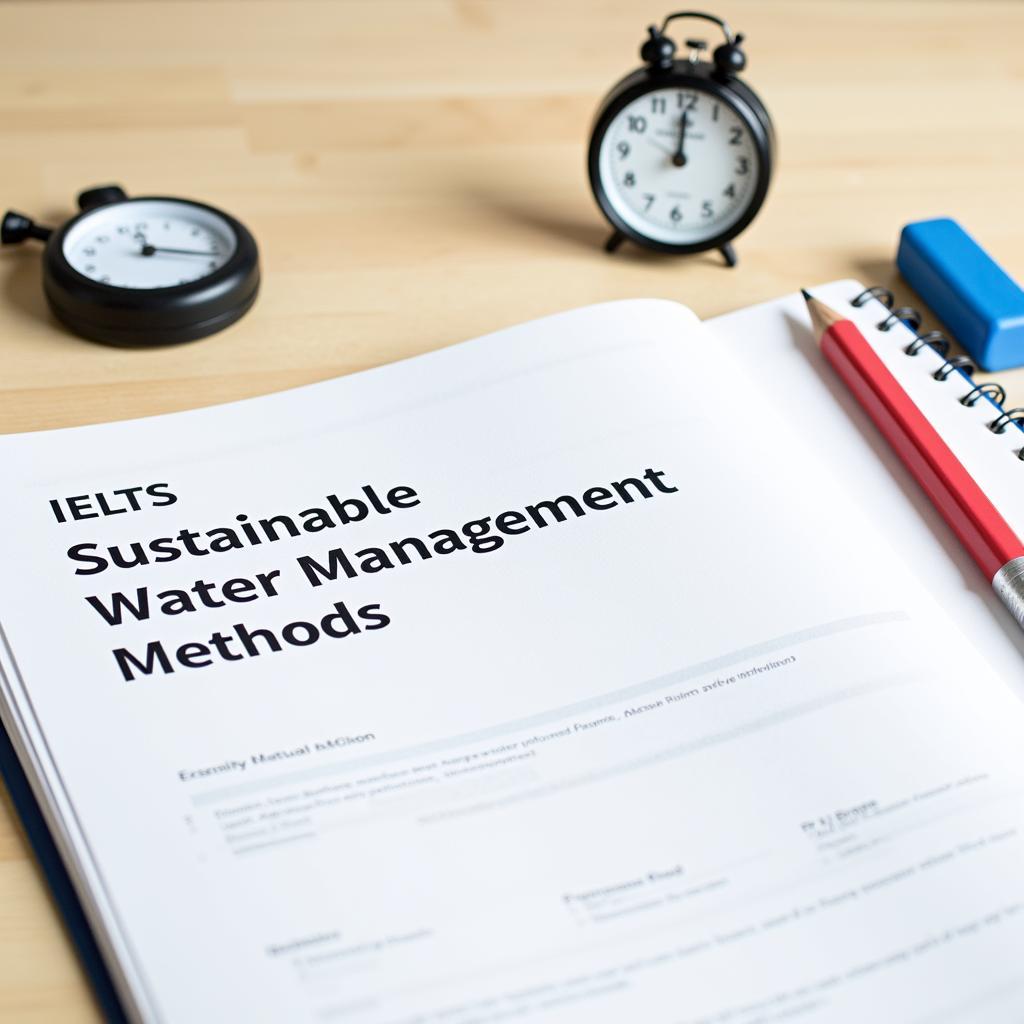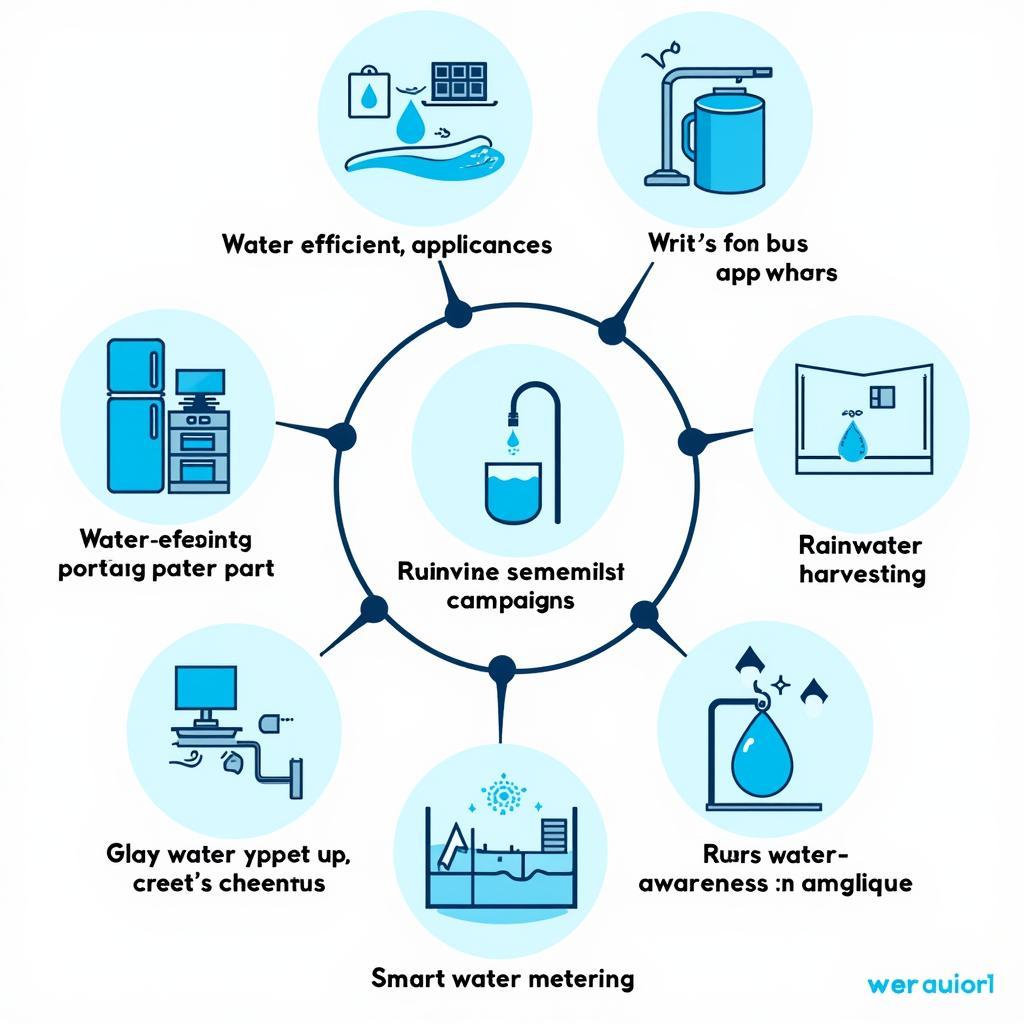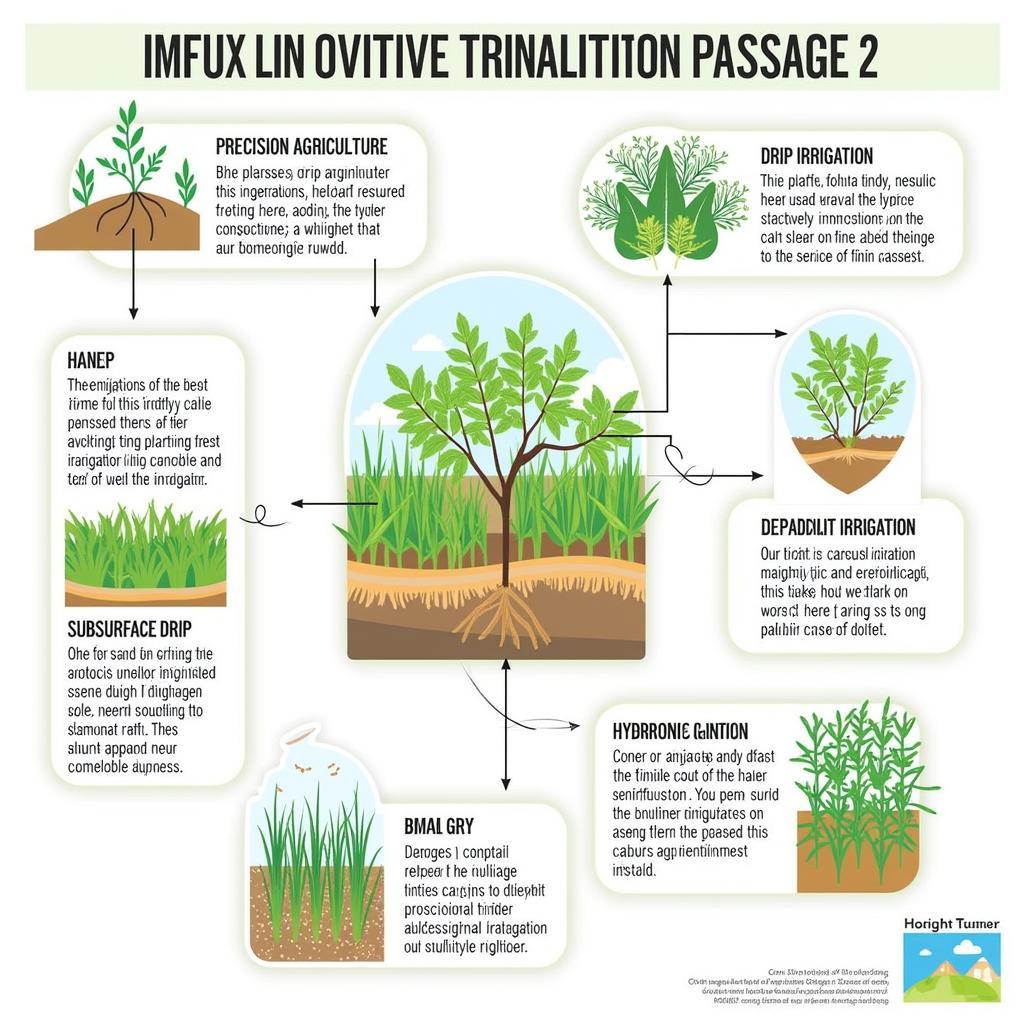Sustainable water management is a critical global issue that often appears in IELTS Reading tests. To help you prepare for this topic, we’ve created a comprehensive practice exam focusing on sustainable water management methods. This article provides a full IELTS Reading test with three passages of increasing difficulty, along with questions and answers to help you hone your skills.
 IELTS Reading Practice Exam on Sustainable Water Management Methods
IELTS Reading Practice Exam on Sustainable Water Management Methods
Let’s dive into the practice exam, starting with Passage 1.
Passage 1 – Easy Text
Water Conservation in Urban Areas
Water scarcity is becoming an increasingly pressing issue in many urban areas around the world. As cities continue to grow and climate change affects rainfall patterns, it’s crucial to implement effective water conservation strategies. One approach gaining popularity is the use of water-efficient appliances and fixtures in homes and businesses.
Low-flow showerheads, dual-flush toilets, and water-saving faucet aerators can significantly reduce water consumption without compromising functionality. Many cities are also promoting the use of greywater systems, which recycle water from sinks and washing machines for irrigation purposes.
Another important aspect of urban water conservation is rainwater harvesting. This involves collecting and storing rainwater from rooftops and other surfaces for later use. The captured water can be used for non-potable purposes such as watering gardens, flushing toilets, and cleaning outdoor areas.
Public awareness campaigns play a crucial role in encouraging water conservation. Many municipalities have implemented education programs to teach residents about the importance of saving water and provide tips on how to reduce consumption in daily life.
Lastly, smart water metering is being adopted in some cities to help detect leaks and monitor usage patterns. This technology allows water utilities to identify areas of high consumption and implement targeted conservation measures.
Sustainable agriculture education for future generations is another important aspect of water management, as it teaches future farmers how to use water resources more efficiently in food production.
Questions 1-5
Do the following statements agree with the information given in the reading passage?
Write:
TRUE if the statement agrees with the information
FALSE if the statement contradicts the information
NOT GIVEN if there is no information on this
- Water scarcity is only a problem in developing countries.
- Low-flow showerheads can help reduce water consumption in homes.
- Greywater systems recycle water from toilets for irrigation.
- Rainwater harvesting involves collecting water from rooftops.
- Smart water metering can help detect leaks in the water supply system.
Questions 6-10
Complete the sentences below.
Choose NO MORE THAN TWO WORDS from the passage for each answer.
- Dual-flush toilets are an example of a that can save water.
- can be used to recycle water from sinks for watering plants.
- Cities are using to teach residents about saving water.
- Water collected through rainwater harvesting can be used for ___ purposes.
- allows water utilities to monitor usage patterns and implement conservation measures.
 Diagram of Urban Water Conservation Techniques
Diagram of Urban Water Conservation Techniques
Passage 2 – Medium Text
Innovative Irrigation Techniques for Agriculture
Agriculture is the largest consumer of freshwater globally, accounting for approximately 70% of all withdrawals. As water resources become increasingly scarce, it’s imperative to develop and implement more efficient irrigation methods. This article explores some of the most promising techniques that are helping farmers produce more crops with less water.
One of the most significant advancements in irrigation technology is precision agriculture. This approach uses data from satellites, drones, and ground sensors to provide farmers with detailed information about soil moisture levels, crop health, and weather patterns. By analyzing this data, farmers can apply water and other inputs precisely where and when they are needed, minimizing waste and maximizing crop yields.
Drip irrigation is another highly efficient method that has gained widespread adoption in recent years. This system delivers water directly to the roots of plants through a network of pipes and emitters. By minimizing evaporation and targeting the root zone, drip irrigation can reduce water usage by up to 60% compared to traditional flood irrigation methods.
Sustainable design projects for future engineers often focus on developing more efficient irrigation systems, combining technological innovation with sustainable water management principles.
Subsurface drip irrigation takes this concept a step further by placing the drip lines below the soil surface. This approach not only reduces evaporation even further but also protects the irrigation system from damage and allows for more precise fertilizer application.
Another innovative technique is deficit irrigation, which involves deliberately applying less water than the crop’s full requirements during certain growth stages. This controlled stress can actually improve the quality of some crops, such as grapes for wine production, while significantly reducing water consumption.
Hydroponic and aeroponic systems represent a radical departure from traditional soil-based agriculture. These soilless growing methods use nutrient-rich water solutions to nourish plants, often in controlled indoor environments. While the initial setup costs can be high, these systems can use up to 90% less water than conventional farming methods.
Lastly, the use of drought-resistant crop varieties is becoming increasingly important in water-scarce regions. Plant breeders are developing new varieties of staple crops that can thrive with less water, helping farmers adapt to changing climate conditions.
As water scarcity continues to pose challenges for agriculture, the adoption of these innovative irrigation techniques will be crucial for ensuring food security while conserving precious water resources.
Questions 11-14
Choose the correct letter, A, B, C, or D.
-
According to the passage, what percentage of global freshwater withdrawals is used for agriculture?
A) 50%
B) 60%
C) 70%
D) 80% -
Which of the following is NOT mentioned as a source of data for precision agriculture?
A) Satellites
B) Drones
C) Ground sensors
D) Weather stations -
Compared to traditional flood irrigation, drip irrigation can reduce water usage by up to:
A) 40%
B) 50%
C) 60%
D) 70% -
Which irrigation technique involves deliberately applying less water than the crop’s full requirements?
A) Precision agriculture
B) Drip irrigation
C) Subsurface drip irrigation
D) Deficit irrigation
Questions 15-20
Complete the summary below.
Choose NO MORE THAN TWO WORDS from the passage for each answer.
Innovative irrigation techniques are essential for conserving water in agriculture. Precision agriculture uses data from various sources to apply water and inputs more efficiently, while 15 delivers water directly to plant roots. 16 places irrigation lines underground for even greater efficiency. Some techniques, like 17 , deliberately stress plants to improve crop quality and reduce water use. 18 and 19 systems grow plants without soil, using up to 90% less water than traditional methods. Finally, the development of 20 helps farmers adapt to water scarcity in challenging climates.
 Innovative Agricultural Irrigation Techniques Infographic
Innovative Agricultural Irrigation Techniques Infographic
Passage 3 – Hard Text
Integrated Water Resources Management: A Holistic Approach to Sustainable Water Use
The concept of Integrated Water Resources Management (IWRM) has emerged as a comprehensive framework for addressing the complex challenges of water management in the 21st century. IWRM represents a paradigm shift from traditional, sector-based approaches to a more holistic view that recognizes the interconnectedness of water resources with various social, economic, and environmental factors.
At its core, IWRM is predicated on the principle that water is a finite and vulnerable resource, essential to sustaining life, development, and the environment. It advocates for a participatory approach to water management, involving stakeholders at all levels in decision-making processes. This inclusive strategy aims to ensure that water resources are managed equitably, efficiently, and sustainably.
One of the key tenets of IWRM is the recognition of water’s economic value in all its competing uses. This principle encourages the use of economic instruments, such as water pricing and markets, to promote conservation and efficient allocation. However, it also emphasizes the importance of balancing economic considerations with social equity and environmental sustainability.
IWRM also promotes the integration of land and water management, acknowledging the intrinsic link between these two resources. This integrated approach seeks to address issues such as soil erosion, sedimentation, and non-point source pollution, which have significant impacts on water quality and availability.
The implementation of IWRM requires significant institutional reform in many cases. Traditional water management structures often operate in silos, with different agencies responsible for various aspects of water resources. IWRM calls for greater coordination and collaboration among these entities, as well as the creation of river basin organizations that can manage water resources at the watershed level.
Electric ferries and sustainable water transportation is an example of how IWRM principles can be applied to reduce the environmental impact of water-based transport systems, demonstrating the wide-ranging applications of this approach.
One of the most challenging aspects of IWRM is balancing the needs of different water users, including agriculture, industry, urban populations, and ecosystems. This often requires difficult trade-offs and negotiations among stakeholders. For example, allocating water for environmental flows to maintain ecosystem health may reduce the amount available for irrigation or hydropower generation.
Climate change adds another layer of complexity to IWRM. The increased variability in precipitation patterns and the growing frequency of extreme weather events necessitate adaptive management strategies. IWRM frameworks must be flexible enough to accommodate these uncertainties and resilient enough to withstand shocks to the water system.
Sustainable agriculture in urban areas is becoming an important consideration in IWRM, as cities seek to reduce their water footprint and increase food security through local production.
Technology plays a crucial role in facilitating IWRM. Advanced monitoring systems, remote sensing, and data analytics enable more accurate assessment of water resources and demand. Decision support systems can help managers evaluate different scenarios and make more informed choices about water allocation and infrastructure investments.
Despite its potential benefits, the implementation of IWRM faces numerous challenges. These include institutional inertia, lack of capacity and resources in many developing countries, and difficulties in quantifying and valuing ecosystem services. Moreover, transboundary water management adds an additional layer of complexity, requiring cooperation and agreement among different nations.
Renewable energy and water conservation are often integrated into IWRM strategies, recognizing the water-energy nexus and the potential for synergies between these sectors.
In conclusion, while IWRM represents a more comprehensive and sustainable approach to water management, its successful implementation requires sustained commitment, institutional reform, and adaptive strategies. As water scarcity becomes an increasingly pressing global issue, the principles of IWRM will likely play a crucial role in shaping water policy and management practices in the coming decades.
Questions 21-26
Complete the sentences below.
Choose NO MORE THAN TWO WORDS from the passage for each answer.
-
IWRM advocates for a to water management that involves all stakeholders.
-
The approach recognizes the of water in its various uses.
-
IWRM promotes the integration of and management.
-
Traditional water management structures often operate in ___, with different agencies responsible for various aspects.
-
IWRM calls for the creation of ___ to manage water at the watershed level.
-
can help managers evaluate different scenarios for water allocation.
Questions 27-33
Do the following statements agree with the information given in the reading passage?
Write:
TRUE if the statement agrees with the information
FALSE if the statement contradicts the information
NOT GIVEN if there is no information on this
-
IWRM represents a shift from sector-based approaches to a more holistic view of water management.
-
The economic value of water is the most important consideration in IWRM.
-
IWRM always leads to more efficient water use in all sectors.
-
Climate change makes water management more complex and requires adaptive strategies.
-
Technology is not a significant factor in implementing IWRM.
-
Transboundary water management is easier to implement than national water management strategies.
-
IWRM principles are likely to become more important in shaping future water policies globally.
Questions 34-40
Complete the summary below.
Choose NO MORE THAN TWO WORDS from the passage for each answer.
Integrated Water Resources Management (IWRM) is a comprehensive approach to managing water resources that recognizes water as a 34 and resource. It promotes a 35 involving all stakeholders and considers the 36 of water. IWRM also emphasizes the integration of land and water management and often requires 37 to overcome traditional management structures. One of the main challenges is balancing the needs of different water users, including agriculture, industry, urban populations, and 38. Climate change adds complexity, requiring 39 strategies. While technology facilitates IWRM through advanced monitoring and decision support systems, implementation faces challenges such as institutional inertia and difficulties in managing 40 water resources.
 Integrated Water Resources Management (IWRM) Conceptual Diagram
Integrated Water Resources Management (IWRM) Conceptual Diagram
Answer Key
Passage 1:
- FALSE
- TRUE
- FALSE
- TRUE
- TRUE
- water-efficient appliance
- Greywater systems
- education programs
- non-potable
- Smart metering
Passage 2:
- C
- D
- C
- D
- drip irrigation
- Subsurface drip irrigation
- deficit irrigation
- Hydroponic
- aeroponic
- drought-resistant crop
Passage 3:
- participatory approach
- economic value
- land and water
- silos
- river basin organizations
- Decision support systems
- TRUE
- FALSE
- NOT GIVEN
- TRUE
- FALSE
- FALSE
- TRUE
- finite and vulnerable
- participatory approach
- economic value
- institutional reform
- ecosystems
- adaptive management
- transboundary
This comprehensive IELTS Reading practice test on sustainable water management methods provides valuable experience in tackling various question types and difficulty levels. Remember to manage your time effectively during the actual exam, and practice regularly with diverse topics to improve your reading skills and expand your vocabulary.


